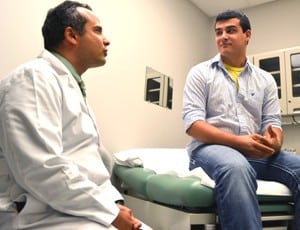UAMS Testicular Cancer Patient First to Have Robotic Surgery
July 15, 2011 | Mohamed Kamel, M.D., a urologic-oncologist at the University of Arkansas for Medical Sciences (UAMS), recently performed the first minimally invasive robotic surgery in Arkansas to remove lymph nodes in a patient with testicular cancer. Kamel, using the da Vinci Surgical System robot, was able to remove the cancerous tissue and get Colton Waters, 21, back on his feet much more quickly than if Waters had had a traditional open-incision surgery. “This is a significant treatment advance for these young men who get testicular cancer,” said Kamel, an assistant professor in the UAMS College of Medicine. “It greatly reduces pain, recovery time and scarring, and yet it is just as effective as open surgery.” Waters’ journey to UAMS started with recurring back pain in the fall of 2010, just as he was starting school at Henderson State University in Arkadelphia. “I had just started the fall semester, so I thought the pain was because I was sleeping on a different bed,” Waters said. In October, he developed a low-grade fever that suddenly spiked to 103 degrees, so he went to a hospital in Texarkana. A CT scan found a mass on his scrotum, and his right testicle was removed less than a week later. The urologic surgeon in Texarkana then referred Waters to Kamel. After Kamel discussed the case with other members of the UAMS cancer team, Waters was seen by Imran Ahmad, M.D., a hematologist-oncologist who oversaw three months of chemotherapy treatments before Waters returned to Kamel to discuss surgery. “I was just kind of in shock; it didn’t really hit me that I had cancer until I started going through chemotherapy,” Waters said. Surgery was required to remove the lymph nodes that extend all along the major blood vessels from the heart because that’s where testicular cancer first spreads. A traditional open surgery requires a foot-long incision that leads to a long and painful recovery. A robotic approach would require six inch-long incisions, with a return to normal activities in a matter of weeks as opposed to about three months. Waters said he didn’t hesitate when offered the robotic surgery. “I knew I would rather have six small scars rather than one massive scar down the middle of my stomach,” he said. Two months after surgery, Waters said he feels great and has resumed his regular activities, including pickup basketball games with friends. Testicular cancer is the most common cancer for men ages 18 to 35, with that age group receiving 53.7 percent of all testicular cancer diagnoses, according to the National Cancer Institute. The American Cancer Society estimated that about 8,480 new cases of testicular cancer would be diagnosed in the United States in 2010 and that about 350 men would die of testicular cancer. Although the rate of testicular cancer has been rising, it is not common; a man’s lifetime chance of developing testicular cancer is about 1 in 270, according to the American Cancer Society. Because treatment is so successful, the risk of dying from this cancer is about 1 in 5,000. |
